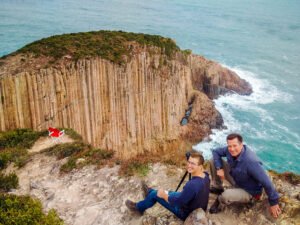Our survival in nature in Finnmark, to everyone’s relief, is both less harmful to canines and more scrumptious. Cooking for SeilNorge is Qaaqqutsiaq “Tipi” Lynge, a renowned chef from Greenland, who somehow conjures mouth-watering, multi-course feasts from a cramped galley: Korean tacos with pork, kimchi and peanut sauce; roasted broccoli with sweet potatoes and fresh-baked bread; bratwurst and apple crumble with whipped cream for dessert. The servings are so generous that even our crew of tired and hungry skiers barely manages to clean our plates. Total silence ensues whenever meals are served, and not because we have nothing to talk about.
We take turns doing the dishes and tidying up, ensuring the cupboards are firmly latched and loose objects are tucked away before setting sail. The quarters below deck are comfortable, if a bit cramped, in part because there’s wet ski gear hanging everywhere to dry, including in the two bathrooms that the 10 people aboard must share. But who needs showers when you have the sea? “I wash everyone,” Grimsæth announces a little too gleefully after a wave crashes broadside into the boat, soaking me and the others on deck.
I forgive him instantly. Who wouldn’t, with his goofy grin and equally goofy (yet undeniably warm) fur hat with ear flaps, which he wears to ward off the windchill as we sail? His buoyant charisma is undergirded by the quiet competence of someone who has weathered, all alone, the craziest seas the Arctic can throw at a sailboat. He’s essentially a poster boy for friluftsliv: part athlete, part artist, part philosopher of the deeps. “In the valley of a wave, you feel like nothing else exists,” he says, as the boat plunges into exactly that kind of oblivion. “But on the crest of a wave,” he exults as the boat rises, “you feel on top of the world.”














